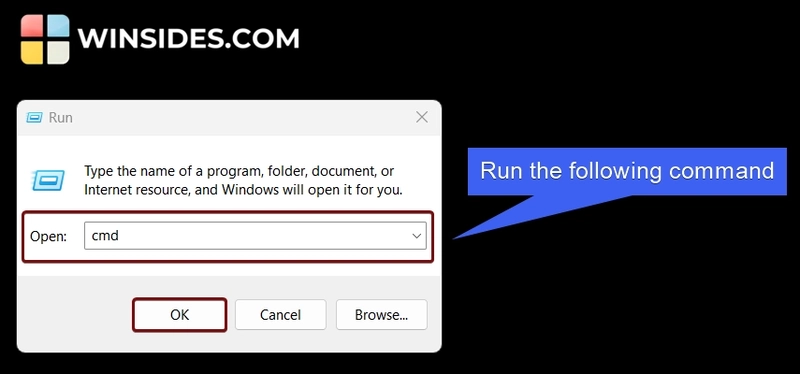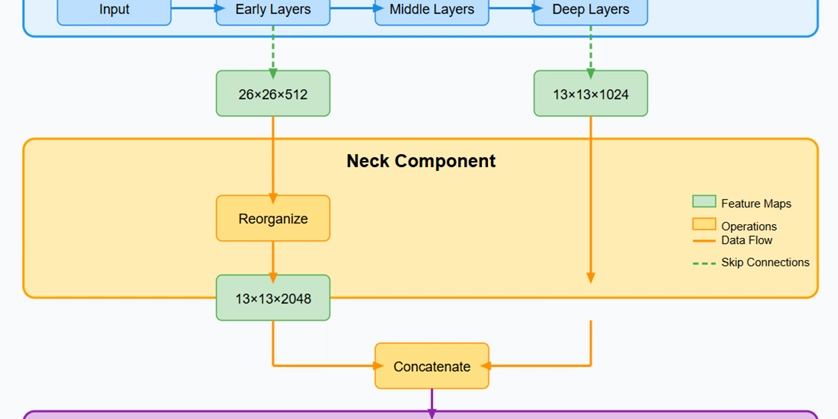What is servicehost.exe on Windows 11?
Servicehost.exe on Windows 11 : To fully understand how servicehost.exe works, we should know the DLL mechanism. DLL, the short form of Dynamic Link Library, is a file that contains code , data , resources , etc. that programs and services use on Windows 11. However, a DLL cannot run by itself. That’s where svchost.exe comes into the picture. The DLL file must be loaded by an executable file like svchost.exe. Windows Services written as DLLs rely on servicehost.exe to launch and manage them in memory. How are DLL and Servicehost.exe connected? How does servicehost.exe (svchost.exe) work on Windows 11? On Windows 11, svchost.exe groups services effectively for better output Instead of running every program and service separately, svchost.exe groups related processes to conserve memory and reduce the system load on the Windows process. For example, on Windows 11, when svchost.exe is hosting network-related services, it might be running several related services like DHCP , Dnscache , NlaSvc , WinHttpAutoProxySvc , etc. The working mechanism was different before Windows 10 (v1703 update). Before the mentioned Windows 10, and particularly on Windows XP, things were a little clumsy as servicehost.exe used to group unrelated services like audio and network running in the same process. Microsoft optimized this effectively on Windows 11 by grouping similar services, ensuring better isolation , easier troubleshooting , and better stability. Irrelevant Grouping is very rare on Windows 11 and is generally avoided. Is Servicehost.exe a Virus? Is Servicehost.exe a virus? Technically speaking, Servicehost.exe is not a virus. It is an essential Windows System process. However, there is one valid point that is worth considering when we are dealing with svchost.exe. Just look for where it is running from, by default, svchost.exe follows the file path C:\Windows\System32. If you find it running from a different path, then it can be a malware impersonation. How to check the path of the servicehost.exe processes? Kindly follow the steps below to check the path of the svchost.exe on Windows 11. Open Task Manager using the shortcut CTRL + ALT + DEL. Under Processes , you can find various processes running. In my Asus G15 Rig, at this instance, there are several Serviceshost.exe running, such as Service Host: UtcSvc , Service Host: State Repository Service , Service Host: Windows Log , Service Host: DCOM Server Process Launcher , etc. Various servicehost.exe services are running on my Windows 11 Let’s check the location of the Service Host: Windows Event Log. Right-click on the Service and click Properties. Right-click on the Service and click Properties Under Location, you can find the path C:\Windows\System32. This ensures that it is a legitimate process. Check the location of the services Using the above steps, you can check the authenticity of the svchost.exe running on your Windows 11. Why are Multiple Services Host Running in the Task Manager? Various svchost.exe running in the Task Manager We can find all the foreground and background processes running in the Task Manager. Servicehost.exe is a Windows System Process and it will always be running in the Task Manager because Multiple Services use it to operate, especially the system services that are built using the DLL files. Hence, if you find “ multiple services host ” in the Task Manager, then you don’t have to worry as long as their location is on C:\Windows\System32 How to Map Processes to Services on Windows 11? svchost.exe is a legitimate Windows process, however, there are several red flags like svch0st.exe , expl0rer.exe , serviceshost.exe , etc. Such terms mimic the system processes, but are malware impersonations. At any point in time, if you suspect that you may be facing such issues on your Windows 11, then you can use the following method to understand all the servicehost.exe processes. Go to the Run Command (you can use the keyboard shortcut Win Key + R) and run the following command. cmd Run the following command In the Command Prompt, kindly execute the following command. tasklist /svc Execute the following command in the CMD This command will list all the servicehost.exe information. Various servicehost.exe services are running You can find various svchost.exe processes running here, some are grouped, and some run individually depending on the nature of the Services. PID is Process ID and is unique and assigned by Windows to every process running in your system. If you find any red flags running here, then you can get to know that there is a malware impersonation. SVCHOST.exe – Frequently Asked Questions In this section, let’s discuss some of the most common questions raised by users while discussing servicehost.exe on Windows 11. Can I end a Servicehost.exe process? It is generally not recommended unless you are fully
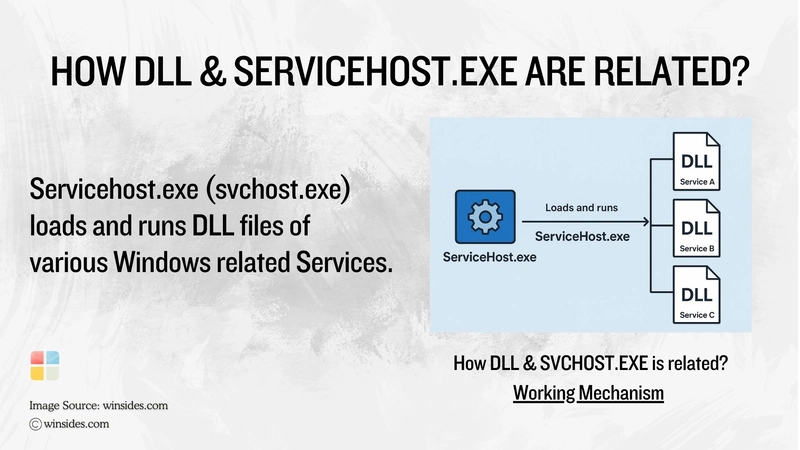
Servicehost.exe on Windows 11 : To fully understand how servicehost.exe works, we should know the DLL mechanism. DLL, the short form of Dynamic Link Library, is a file that contains code , data , resources , etc. that programs and services use on Windows 11.
However, a DLL cannot run by itself. That’s where svchost.exe comes into the picture. The DLL file must be loaded by an executable file like svchost.exe. Windows Services written as DLLs rely on servicehost.exe to launch and manage them in memory.

How are DLL and Servicehost.exe connected?
How does servicehost.exe (svchost.exe) work on Windows 11?
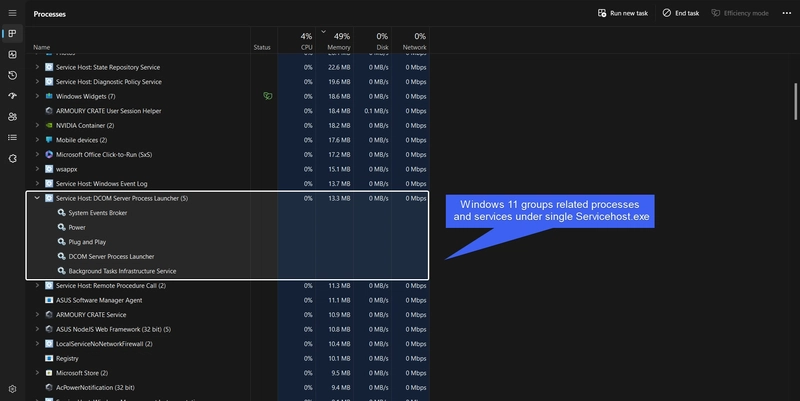
On Windows 11, svchost.exe groups services effectively for better output
Instead of running every program and service separately, svchost.exe groups related processes to conserve memory and reduce the system load on the Windows process. For example, on Windows 11, when svchost.exe is hosting network-related services, it might be running several related services like DHCP , Dnscache , NlaSvc , WinHttpAutoProxySvc , etc.
The working mechanism was different before Windows 10 (v1703 update). Before the mentioned Windows 10, and particularly on Windows XP, things were a little clumsy as servicehost.exe used to group unrelated services like audio and network running in the same process.
Microsoft optimized this effectively on Windows 11 by grouping similar services, ensuring better isolation , easier troubleshooting , and better stability. Irrelevant Grouping is very rare on Windows 11 and is generally avoided.
Is Servicehost.exe a Virus?
Technically speaking, Servicehost.exe is not a virus. It is an essential Windows System process. However, there is one valid point that is worth considering when we are dealing with svchost.exe. Just look for where it is running from, by default, svchost.exe follows the file path C:\Windows\System32. If you find it running from a different path, then it can be a malware impersonation.
How to check the path of the servicehost.exe processes?
Kindly follow the steps below to check the path of the svchost.exe on Windows 11.
- Open Task Manager using the shortcut CTRL + ALT + DEL.
- Under Processes , you can find various processes running.
- In my Asus G15 Rig, at this instance, there are several Serviceshost.exe running, such as Service Host: UtcSvc , Service Host: State Repository Service , Service Host: Windows Log , Service Host: DCOM Server Process Launcher , etc.
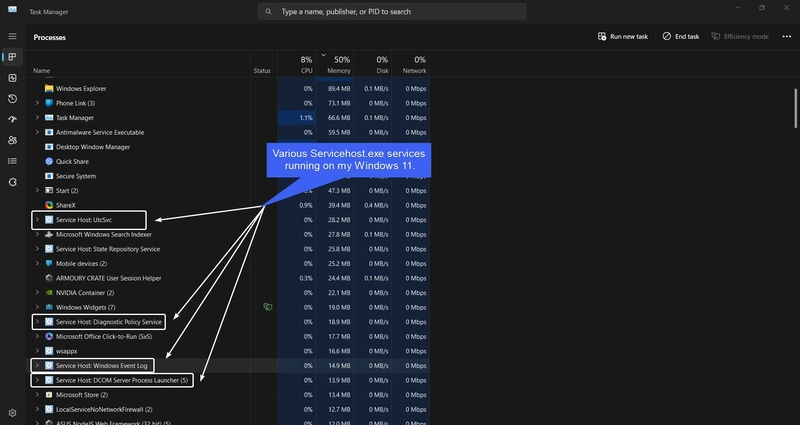
Various servicehost.exe services are running on my Windows 11
- Let’s check the location of the Service Host: Windows Event Log. Right-click on the Service and click Properties.
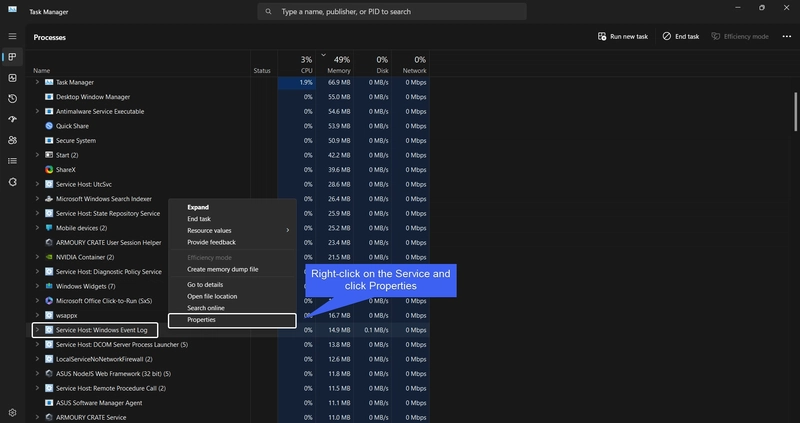
Right-click on the Service and click Properties
- Under Location, you can find the path
C:\Windows\System32. This ensures that it is a legitimate process.
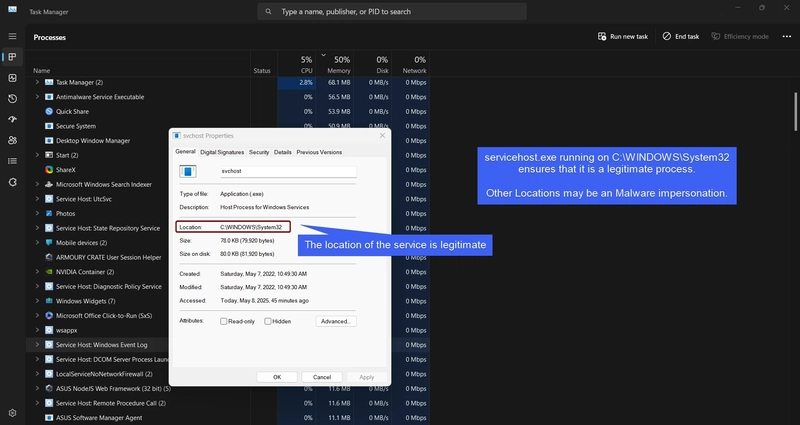
Check the location of the services
- Using the above steps, you can check the authenticity of the svchost.exe running on your Windows 11.
Why are Multiple Services Host Running in the Task Manager?
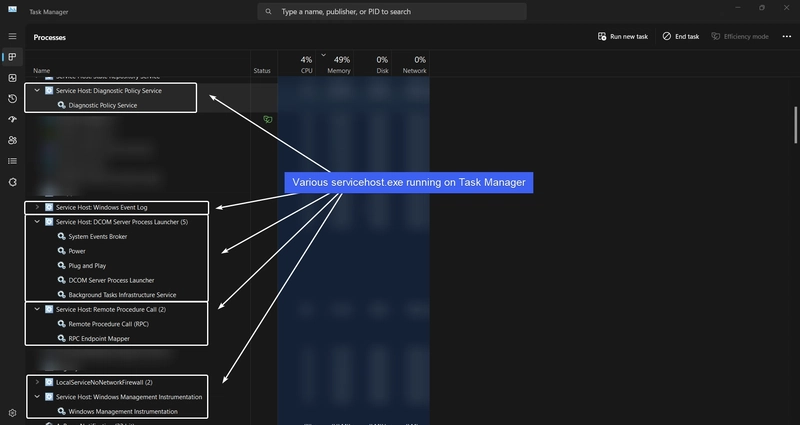
Various svchost.exe running in the Task Manager
We can find all the foreground and background processes running in the Task Manager. Servicehost.exe is a Windows System Process and it will always be running in the Task Manager because Multiple Services use it to operate, especially the system services that are built using the DLL files. Hence, if you find “ multiple services host ” in the Task Manager, then you don’t have to worry as long as their location is on C:\Windows\System32
How to Map Processes to Services on Windows 11?
svchost.exe is a legitimate Windows process, however, there are several red flags like svch0st.exe , expl0rer.exe , serviceshost.exe , etc. Such terms mimic the system processes, but are malware impersonations. At any point in time, if you suspect that you may be facing such issues on your Windows 11, then you can use the following method to understand all the servicehost.exe processes.
- Go to the Run Command (you can use the keyboard shortcut Win Key + R) and run the following command.
cmd
- In the Command Prompt, kindly execute the following command.
tasklist /svc
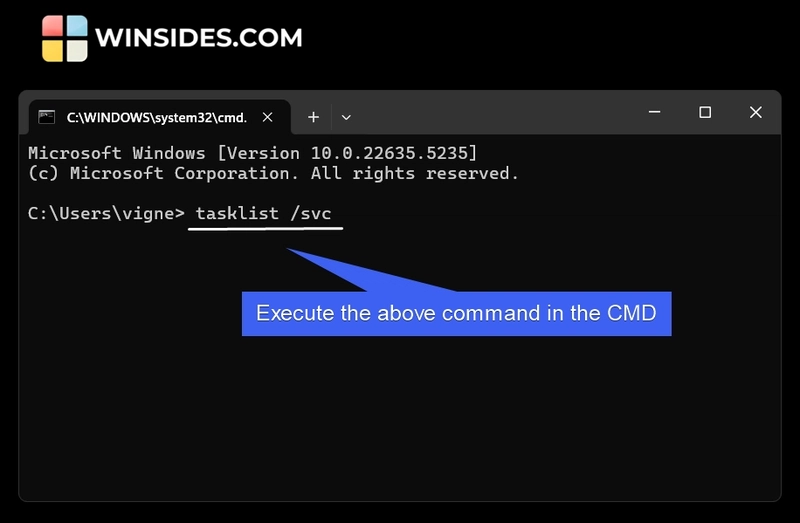
Execute the following command in the CMD
- This command will list all the servicehost.exe information.
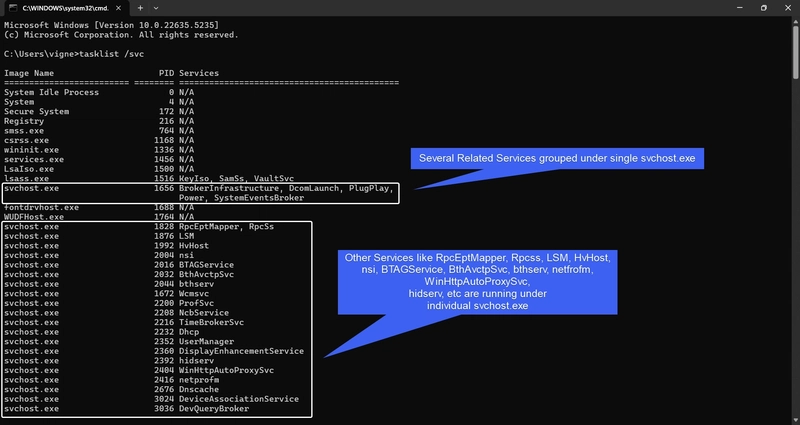
Various servicehost.exe services are running
- You can find various svchost.exe processes running here, some are grouped, and some run individually depending on the nature of the Services. PID is Process ID and is unique and assigned by Windows to every process running in your system.
- If you find any red flags running here, then you can get to know that there is a malware impersonation.
SVCHOST.exe – Frequently Asked Questions
In this section, let’s discuss some of the most common questions raised by users while discussing servicehost.exe on Windows 11.
Can I end a Servicehost.exe process?
It is generally not recommended unless you are fully aware of which services you are terminating. Ending svchost.exe processes abruptly may crash the system.
Can malware hide inside Servicehost.exe?
It is possible. Though servicehost.exe is legit, there can be impersonations via malicious DLLs registered as Services. Monitoring service behavior and checking digital signatures helps detect it.
How can I troubleshoot svchost.exe issues?
You can use the Task Manager , Event Viewer , Resource Monitor , Process Explorer like tasklist /svc , to isolate and analyze the issue.
Is it possible to change which services run inside which ServiceHost group?
Technically, yes, it is possible using the Windows Registry Editor, however, it is not recommended unless you are an IT Expert with a deep understanding of the process.
Why does Servicehost.exe sometimes relaunch itself instantly after ending it?
It happens because Windows Services are set to auto restart by the Service Control Manager inorder to maintain the system stability. When we end svchost.exe, it just kills the wrapper and not the service policy entangled to it.
Can servicehost.exe run non DLL Services?
No, because it defies the actual purpose of svchost.exe itself. It can only host services implemented as DLLs. Services that are implemented as EXE will run as a standalone process. For example, Google Chrome browser running in the Task Manager as “chrome.exe”
Take Away
Servicehost.exe on Windows 11 is a crucial process that handles various Windows system processes. If you are on Task Manager, and wonder why so many svchost.exe running, don’t worry, in most cases, they are running some of the crucial services that maintain the system stability for its full functioning. Having said that, it can be misused by malware, and hence, we advise our users to avoid visiting spammy websites , downloading spammy content , and be extra cautious with USB sticks and online activities.
Have Queries?
If you have any queries or if you face any difficulties following the above steps, kindly let us know in the comments. For more interesting and safe computer management articles, stay tuned to Winsides.com. Happy Computing! Peace out!








































































































































































![[The AI Show Episode 146]: Rise of “AI-First” Companies, AI Job Disruption, GPT-4o Update Gets Rolled Back, How Big Consulting Firms Use AI, and Meta AI App](https://www.marketingaiinstitute.com/hubfs/ep%20146%20cover.png)


























































































































![[DEALS] The Premium Python Programming PCEP Certification Prep Bundle (67% off) & Other Deals Up To 98% Off – Offers End Soon!](https://www.javacodegeeks.com/wp-content/uploads/2012/12/jcg-logo.jpg)














































































































-Mafia-The-Old-Country---The-Initiation-Trailer-00-00-54.png?width=1920&height=1920&fit=bounds&quality=70&format=jpg&auto=webp#)
-Nintendo-Switch-2---Reveal-Trailer-00-01-52.png?width=1920&height=1920&fit=bounds&quality=70&format=jpg&auto=webp#)























_Sergey_Tarasov_Alamy.jpg?width=1280&auto=webp&quality=80&disable=upscale#)









































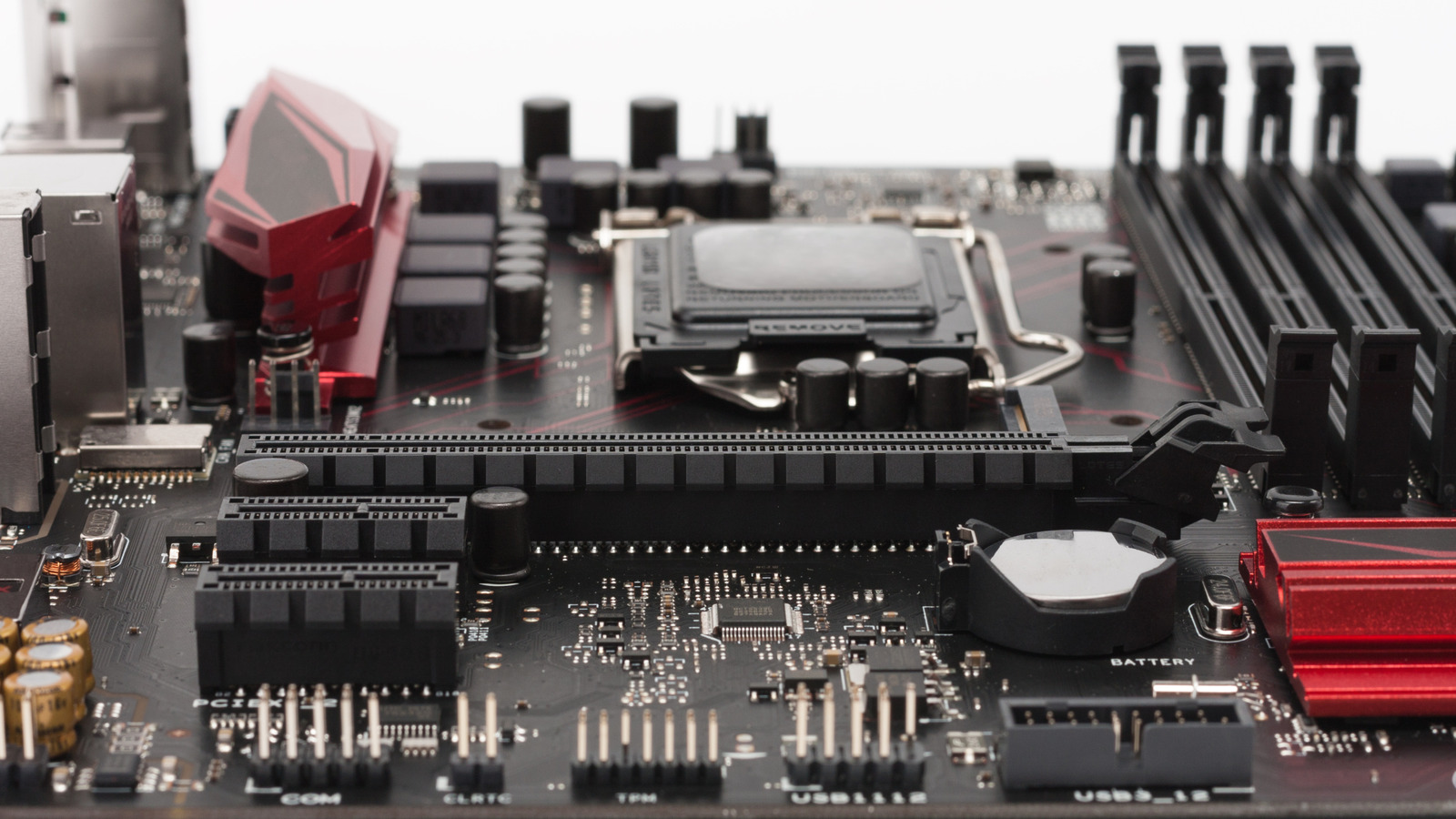



















































![Instacart’s new Fizz alcohol delivery app is aimed at Gen Z [U]](https://i0.wp.com/9to5mac.com/wp-content/uploads/sites/6/2025/05/Instacarts-new-Fizz-alcohol-delivery-app-is-aimed-at-Gen-Z.jpg?resize=1200%2C628&quality=82&strip=all&ssl=1)




















![Beats Studio Pro Wireless Headphones Now Just $169.95 - Save 51%! [Deal]](https://www.iclarified.com/images/news/97258/97258/97258-640.jpg)






























































































